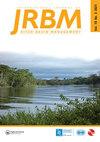An innovative hydrological model for the sparsely-gauged Essequibo River basin, northern Amazonia
IF 1.9
Q3 WATER RESOURCES
International Journal of River Basin Management
Pub Date : 2023-11-14
DOI:10.1080/15715124.2023.2278678
引用次数: 0
Abstract
Tropical river basins – crucial components of global water and carbon cycles – are threatened by logging, mining, agricultural conversion, and climate change. Thus, decision-makers require hydrological impact assessments to sustainably manage threatened basins, such as the ∼68,000 km2 Essequibo River basin in Guyana. Emerging global data products offer the potential to better understand sparsely-gauged basins. We combined new global meteorological and soils data with established in situ observations to build the first physically-based spatially-distributed hydrological model of the Essequibo. We developed new, open source, methods to translate global data (ERA5-Land, WFDE5, MSWEP, and IMERG) into a grid-based SHETRAN model. Comparing the performance of several global and local precipitation and evaporation datasets showed that WFDE5 precipitation, combined with ERA5-Land evaporation, yielded the best daily discharge simulations from 2000 to 2009, with close water balances (PBIAS = −3%) and good discharge peaks (NSE = 0.65). Finally, we tested model sensitivity to key parameters to show the importance of actual to potential evapotranspiration ratios, Strickler runoff coefficients, and subsurface saturated hydraulic conductivities. Our data translation methods can now be used to drive hydrological models nearly anywhere in the world, fostering the sustainable management of the Earth’s sparsely-gauged river basins.一个创新的水文模型为稀疏测量埃塞奎博河流域,亚马逊北部
热带河流流域——全球水和碳循环的重要组成部分——正受到伐木、采矿、农业转型和气候变化的威胁。因此,决策者需要进行水文影响评估,以可持续地管理受威胁的流域,例如圭亚那约68,000平方公里的埃塞奎博河流域。新兴的全球数据产品提供了更好地了解稀疏测量盆地的潜力。我们将新的全球气象和土壤数据与已建立的原位观测相结合,建立了第一个基于物理的空间分布的埃塞奎博水文模型。我们开发了新的开源方法,将全球数据(ERA5-Land, WFDE5, MSWEP和IMERG)转换为基于网格的SHETRAN模型。比较多个全球和局地降水和蒸发数据集的表现表明,2000 - 2009年WFDE5降水与ERA5-Land蒸发相结合获得了最佳的日流量模拟结果,水量平衡接近(PBIAS = - 3%),流量峰值良好(NSE = 0.65)。最后,我们测试了模型对关键参数的敏感性,以显示实际蒸散比、潜在蒸散比、斯特里克勒径流系数和地下饱和水力导率的重要性。我们的数据转换方法现在可以用于驱动世界上几乎任何地方的水文模型,促进对地球上稀少的河流流域的可持续管理。
本文章由计算机程序翻译,如有差异,请以英文原文为准。
求助全文
约1分钟内获得全文
求助全文
来源期刊

International Journal of River Basin Management
WATER RESOURCES-
CiteScore
6.00
自引率
4.00%
发文量
48
期刊介绍:
include, but are not limited to new developments or applications in the following areas: AREAS OF INTEREST - integrated water resources management - watershed land use planning and management - spatial planning and management of floodplains - flood forecasting and flood risk management - drought forecasting and drought management - floodplain, river and estuarine restoration - climate change impact prediction and planning of remedial measures - management of mountain rivers - water quality management including non point source pollution - operation strategies for engineered river systems - maintenance strategies for river systems and for structures - project-affected-people and stakeholder participation - conservation of natural and cultural heritage
 求助内容:
求助内容: 应助结果提醒方式:
应助结果提醒方式:


